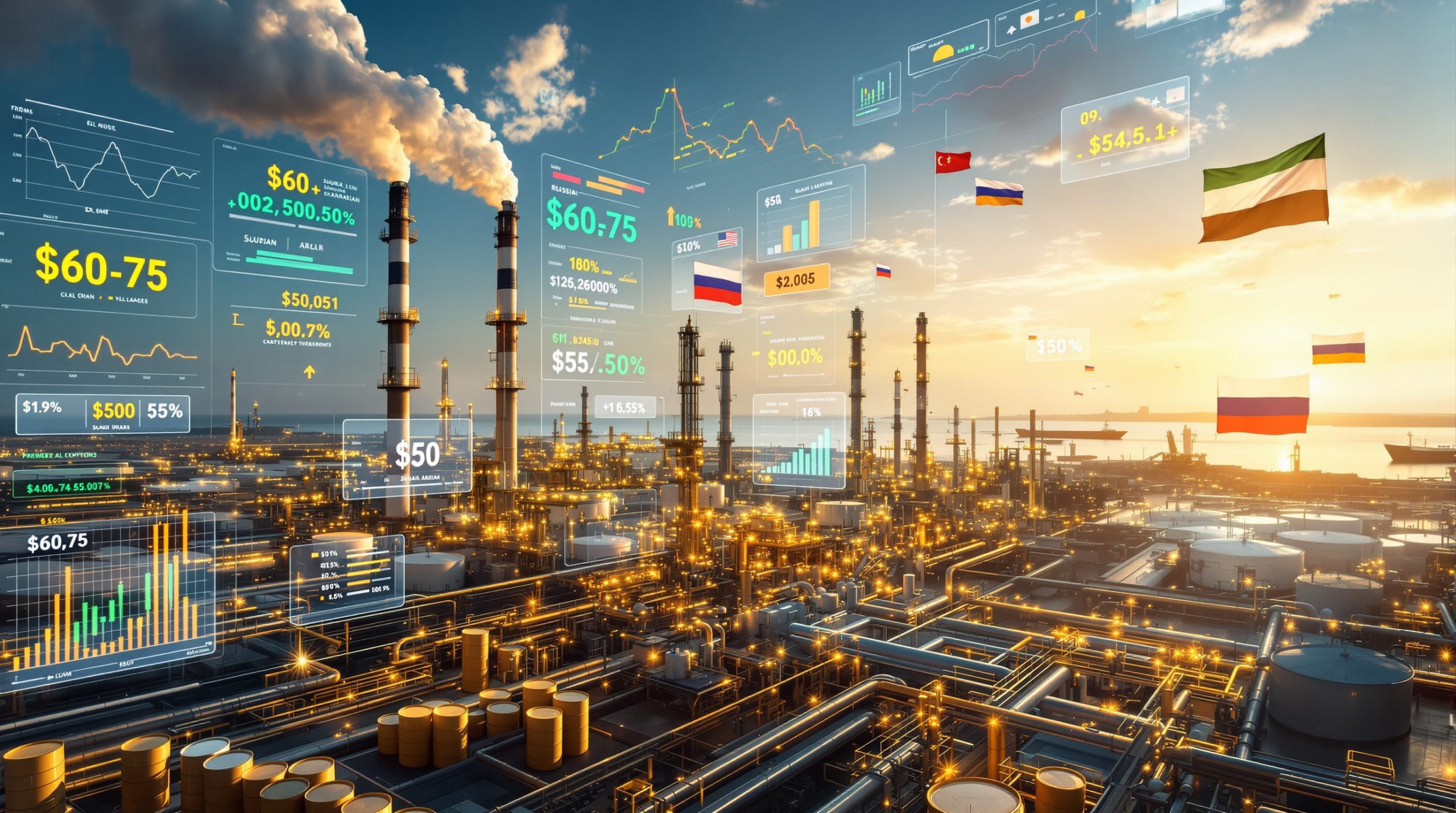The uranium market has demonstrated remarkable resilience and growth throughout 2025, with prices reflecting strengthening fundamentals across both supply and demand factors. Current market conditions reveal a complex interplay between spot pricing mechanisms, long-term contracting strategies, and evolving investment patterns that collectively shape uranium market prices. Furthermore, ongoing developments such as the paladin uranium halt have contributed to supply concerns affecting price dynamics.
Understanding Current Uranium Market Dynamics
Recent market data indicates uranium spot prices concluded October 2025 at $80.00 per pound, according to uranium fuel provider Cameco Corporation. This pricing represents a substantial recovery from the year's lowest point of $64.23 per pound recorded in March 2025, demonstrating approximately 24.5% appreciation over an eight-month period.
Spot vs. Long-Term Contract Pricing Mechanisms
The 2025 trading range has been particularly noteworthy, with uranium market prices reaching a yearly peak of $82.63 per pound in September before settling at current levels. This volatility pattern reflects the underlying tension between constrained supply availability and accelerating demand from utility companies worldwide.
Long-term uranium contracts typically command premiums above spot pricing due to supply security considerations and inflation adjustment mechanisms. These multi-year agreements provide price stability for both producers and utilities while establishing a foundation for sustained market development.
The distinction between spot and contract markets becomes increasingly important as utilities balance immediate procurement needs against long-term fuel security requirements. Physical uranium funds have also emerged as significant price discovery participants, creating additional demand vectors beyond traditional utility purchasing patterns.
Price Discovery Methods in the Uranium Market
Modern uranium pricing operates through multiple interconnected mechanisms that reflect both physical market realities and financial market dynamics. Exchange-based platforms facilitate transparent price discovery through standardised transactions, while bilateral negotiations between producers and utilities establish benchmark pricing for longer-term supply relationships.
The influence of physical uranium investment vehicles has introduced new dynamics to traditional pricing mechanisms. These funds accumulate uranium inventory as financial assets, creating demand pressure that can amplify price movements during periods of supply constraint or utility restocking activities.
Market participants increasingly rely on published price indices and broker networks to establish fair value assessments across different contract structures and delivery timeframes. Additionally, uranium market volatility has become a key consideration for pricing models. This multi-layered approach to price discovery helps ensure market efficiency while accommodating the specialised requirements of nuclear fuel procurement.
How Do Supply Chain Disruptions Impact Uranium Pricing?
Supply chain disruptions represent one of the most significant drivers of uranium market price volatility, with production challenges creating immediate impacts on market sentiment and long-term contract negotiations. The uranium industry's concentrated production base amplifies the effects of operational disruptions at major mining facilities.
Major Production Challenges Affecting Market Rates
Kazakhstan maintains its position as the world's largest uranium producer through state-owned Kazatomprom, making any production adjustments highly consequential for global supply balances. Recent operational decisions by major producers have contributed to tighter market conditions and supported higher uranium market prices throughout 2025.
Canadian mining operations, including historically significant facilities like McArthur River, continue to influence global supply dynamics through production scheduling decisions and operational capacity adjustments. These high-grade deposits represent crucial supply sources during periods of increased market demand.
Secondary supply sources from decommissioned nuclear weapons programmes have provided supplemental uranium availability for decades, though these sources face natural depletion over time. The gradual reduction in secondary supply creates additional pressure on primary mining operations to meet growing utility requirements.
Key Supply Factors Affecting Prices:
• Mine production capacity constraints
• Operational timing delays
• Infrastructure maintenance requirements
• Environmental compliance considerations
• Labour availability challenges
Geopolitical Risk Premiums in Uranium Valuations
Uranium market prices increasingly reflect geopolitical considerations as utilities prioritise supply security alongside cost optimisation. Energy security policies have elevated the importance of domestic and allied-nation uranium sources, creating premium pricing opportunities for producers in politically stable jurisdictions.
Trade policy developments and sanctions considerations influence uranium sourcing decisions, particularly for utilities operating in regions with specific import restrictions or strategic autonomy objectives. For instance, the US Senate bans Russian uranium imports, creating significant market impacts. These policy frameworks can create sustained price premiums for qualifying uranium sources.
The concentration of uranium production in specific geographic regions amplifies geopolitical risk considerations, as supply disruptions in major producing countries can have immediate global market impacts. This dynamic supports risk premiums in uranium market prices during periods of heightened international tensions.
What Role Does Nuclear Energy Demand Play in Price Formation?
Nuclear energy demand fundamentally drives uranium market prices through the direct consumption relationship between reactor operations and fuel requirements. Current global nuclear capacity trends indicate strengthening demand prospects that support higher uranium valuations across multiple market segments.
Global Nuclear Capacity Expansion Drivers
Reactor restart programmes in Japan continue progressing following post-Fukushima safety upgrades, with each facility restart representing immediate uranium demand increases. European nuclear facilities have demonstrated improved capacity factors as operators optimise performance and extend operating licences.
New nuclear construction projects across emerging markets create long-term uranium demand visibility that supports sustained price levels. These projects typically require multi-year fuel procurement strategies that begin years before commercial operation, creating forward demand for uranium supplies.
Small modular reactor development programmes represent potential demand catalysts as deployment timelines advance toward commercial readiness. While initial SMR deployment scales remain modest, successful demonstration projects could accelerate adoption rates and uranium consumption patterns.
Nuclear Capacity Trends Supporting Demand:
• Extended operating licence approvals
• Capacity factor improvements
• New construction project advancement
• Advanced reactor technology development
• Energy security policy support
Energy Security Policies Influencing Uranium Demand
Government energy policies increasingly recognise nuclear power's role in achieving carbon reduction targets while maintaining grid reliability. These policy frameworks create long-term demand stability that supports higher uranium market prices through reduced regulatory uncertainty.
Domestic uranium production incentives and strategic reserve programmes in various countries create additional demand sources beyond traditional utility purchasing. These initiatives can provide price floors during market downturns while supporting sustained production investment.
International climate commitments drive nuclear capacity planning decisions as countries balance emission reduction requirements with economic growth objectives. This policy environment creates multi-decade demand visibility that justifies higher current uranium market prices.
How Do Investment Flows Affect Uranium Market Pricing?
Investment capital allocation to uranium markets has introduced new demand dynamics that complement traditional utility purchasing patterns. Financial market participation creates additional price discovery mechanisms while potentially amplifying volatility during sentiment shifts.
Physical Uranium Fund Accumulation Strategies
Physical uranium investment vehicles accumulate inventory as financial assets, creating demand that operates independently of reactor fuel requirements. These accumulation strategies can create supply tightness that supports higher uranium market prices, particularly during periods of limited mine production flexibility.
Investment-grade uranium stockpiling represents a growing market segment as institutional investors recognise uranium's strategic value and inflation hedge characteristics. This demand source provides market support during utility procurement lulls while creating competition for available supplies.
Investment Demand Characteristics:
• Long-term accumulation strategies
• Price volatility amplification potential
• Supply availability reduction effects
• Market liquidity enhancement
• Sentiment-driven allocation changes
Institutional Investment Patterns in Uranium Markets
Pension funds and sovereign wealth funds have begun incorporating uranium exposure as part of commodity allocation strategies, recognising the element's strategic importance and supply constraint characteristics. These large-scale institutional flows can create sustained demand pressure that supports higher uranium market prices.
ESG investment criteria have created complex considerations for uranium investment, with some funds avoiding nuclear exposure while others recognise nuclear energy's carbon reduction benefits. This divergent approach creates selective demand patterns that can influence specific uranium investment vehicles and pricing dynamics.
What Are the Key Price Forecasting Indicators?
Effective uranium price forecasting requires analysis of both technical market indicators and fundamental supply-demand relationships. Market participants utilise multiple analytical frameworks to assess price direction and volatility expectations across different time horizons.
Technical Analysis Metrics for Uranium Pricing
Moving average convergence patterns provide insights into momentum shifts and trend reversals in uranium market prices. The current price level of $80.00 per pound represents significant technical recovery from March 2025 lows, suggesting sustained upward momentum.
Support and resistance levels derived from historical trading ranges help identify potential price targets and downside protection points. The September 2025 high of $82.63 per pound establishes near-term resistance, while March lows provide psychological support references.
Volume-weighted average price calculations help assess fair value ranges and identify periods of accumulation or distribution activity. These metrics become particularly important when evaluating the sustainability of price movements in relatively illiquid uranium markets. Additionally, understanding uranium tariff impacts helps investors assess policy-related price pressures.
Fundamental Analysis Framework
Demand-Side Analysis Factors:
• Nuclear fuel procurement cycle timing
• Reactor capacity utilisation trends
• Government policy announcement impacts
• New reactor construction schedules
• Licence extension decisions
Supply-Side Analysis Factors:
• Mine production capacity reporting
• Inventory level disclosures
• Exploration expenditure trends
• Development project advancement
• Secondary supply availability
Fundamental analysis requires continuous monitoring of utility fuel requirements, producer capability assessments, and inventory management strategies. These factors interact dynamically to create the underlying price pressure that drives uranium market prices over extended periods.
How Do Seasonal Patterns Influence Uranium Market Prices?
Uranium markets demonstrate cyclical patterns related to utility procurement schedules, reactor maintenance timing, and fiscal year-end contracting activities. Understanding these seasonal dynamics helps market participants optimise timing decisions and anticipate price movement periods.
Quarterly Contracting Cycles
Utility procurement activities typically concentrate around specific calendar periods driven by budget cycle requirements and fuel planning schedules. These concentrated purchasing periods can create temporary demand spikes that influence uranium market prices across quarterly reporting intervals.
Fiscal year-end contract negotiations often occur during fourth quarters as utilities finalise annual procurement strategies and budget allocations. This timing can create price pressure as multiple buyers compete for available supply sources simultaneously.
Reactor maintenance shutdowns during spring and autumn seasons affect immediate fuel requirements while creating opportunities for inventory management adjustments. These operational patterns influence short-term demand timing and spot market activity levels.
Annual Price Volatility Patterns
Historical uranium market prices have exhibited recurring volatility patterns that reflect underlying market structure characteristics and participant behaviour cycles. The 2025 trading range from $64.23 to $82.63 per pound demonstrates approximately 28.7% peak-to-trough volatility, consistent with commodity market norms during supply transition periods.
"Market Observation: Fourth quarter pricing has historically shown strength due to year-end contract renewal activities and utility budget finalisation processes, though specific patterns vary based on overall market conditions."
Annual price patterns also reflect longer-term nuclear fuel cycle requirements, as utilities balance immediate procurement needs against multi-year fuel security objectives. These strategic considerations can create sustained price support during periods of supply uncertainty.
What Market Structure Changes Are Reshaping Uranium Pricing?
Uranium market structure continues evolving as new participants, technologies, and trading mechanisms emerge to improve price discovery and market efficiency. These structural changes influence how uranium market prices are established and maintained across different market segments.
Emerging Trading Platform Developments
Digital marketplace adoption has begun modernising uranium transaction processes, though physical delivery requirements and security considerations limit fully electronic trading implementation. These platforms focus on improving price transparency and transaction efficiency rather than replacing traditional bilateral negotiation processes.
Real-time price discovery mechanisms help market participants access current market information more effectively, reducing information asymmetries that historically characterised uranium trading. Enhanced transparency supports more efficient price formation and reduces transaction costs for market participants.
Contract Structure Evolution
Modern uranium contracts increasingly incorporate flexible pricing formulas that adjust to market conditions while providing baseline price stability for both parties. These mechanisms help balance risk allocation between producers and utilities during volatile market periods.
Multi-year supply agreements have evolved to include escalation clauses and adjustment mechanisms that reflect changing production costs and market dynamics. These structural innovations help sustain long-term supply relationships while adapting to evolving uranium market prices.
Contract Innovation Features:
• Market-indexed pricing components
• Inflation adjustment mechanisms
• Volume flexibility provisions
• Quality specification updates
• Delivery timing optimisation
How Do Currency Fluctuations Impact Uranium Market Values?
Currency exchange rate movements significantly influence uranium market prices due to the industry's dollar-denominated pricing structure and global participant base. Understanding currency impacts helps market participants manage foreign exchange risks and optimise procurement strategies.
USD Denomination Effects on Global Pricing
Uranium market prices are primarily quoted in US dollars, creating exchange rate exposure for international buyers and sellers operating in other currencies. Currency strength variations can effectively change uranium costs for non-dollar participants independent of underlying supply-demand fundamentals.
Regional price premium variations often reflect local currency purchasing power changes and hedging strategy differences among international market participants. These premiums can persist during periods of significant exchange rate volatility, creating arbitrage opportunities for sophisticated traders.
Hedging strategies employed by international buyers help mitigate currency risk exposure while potentially influencing uranium market prices through forward contract activity. Utilities operating in volatile currency environments may adjust procurement timing based on exchange rate expectations.
What Are the Long-Term Price Outlook Scenarios?
Long-term uranium market price projections depend on multiple interacting variables including nuclear capacity growth rates, mine production development timelines, and policy environment evolution. Market participants utilise scenario analysis to evaluate potential price ranges and investment decision frameworks.
Bull Case Projections Through 2030
Optimistic uranium price scenarios assume accelerated nuclear capacity deployment combined with constrained mine production growth, creating sustained supply deficits that support higher pricing levels. These scenarios emphasise nuclear energy's role in decarbonisation strategies and energy security policies.
Nuclear renaissance acceleration could create uranium demand growth rates exceeding historical patterns, particularly if small modular reactor deployment proceeds successfully. Rapid adoption scenarios suggest significant supply chain investment requirements that justify higher uranium market prices.
Positive Price Drivers:
• Accelerated reactor construction timelines
• Extended nuclear plant operating licences
• Reduced secondary supply availability
• Investment fund accumulation strategies
• Geopolitical supply chain diversification
Bear Case Risk Factors
Alternative energy competition could limit nuclear capacity growth if renewable energy costs continue declining and storage technologies improve significantly. These scenarios suggest moderate uranium demand growth that may not justify sustained price premiums.
Regulatory approval delays for new nuclear projects represent significant downside risks for uranium demand projections, as extended licensing processes can postpone fuel procurement requirements for multiple years. Economic recession impacts could also delay utility investment decisions and reduce electricity demand growth.
Economic recession demand destruction scenarios assume reduced industrial electricity consumption and delayed nuclear project development, creating oversupply conditions that pressure uranium market prices downward.
Base Case Market Equilibrium Forecasting
Balanced uranium market scenarios assume moderate nuclear capacity growth consistent with current policy frameworks and reasonable mine production development timelines. These projections typically incorporate gradual demand increases offset by proportional supply development.
Market equilibrium analysis suggests uranium market prices will likely fluctuate within ranges that provide adequate producer incentives while remaining economically attractive for utility fuel procurement strategies. Furthermore, developments like the kayelekera uranium comeback may influence supply dynamics. This balance requires ongoing supply-demand monitoring and adjustment mechanisms.
Equilibrium Considerations:
• Supply response timing to price signals
• Demand growth sustainability factors
• Investment cycle characteristics
• Inventory management strategies
• Policy stability requirements
Frequently Asked Questions About Uranium Pricing
What Causes Uranium Price Spikes?
Uranium price spikes typically result from unexpected supply disruptions combined with inelastic demand characteristics. Major mine operational issues, geopolitical events affecting producing regions, or significant utility procurement announcements can create rapid price adjustments as market participants reassess supply availability.
Market psychology also contributes to price volatility, as uranium's strategic importance creates heightened sensitivity to supply security concerns. Investment fund activity can amplify price movements when financial flows align with underlying fundamental pressures.
How Often Do Uranium Prices Change?
Spot uranium market prices can adjust daily based on transaction activity and market participant sentiment, though published price benchmarks typically update on weekly schedules. Long-term contract prices generally review quarterly or annually depending on specific agreement terms.
Market liquidity influences price change frequency, with active trading periods producing more frequent adjustments while quiet markets may maintain stable pricing for extended periods. Current uranium price monitoring shows the October 2025 price of $80.00 per pound represents the cumulative impact of multiple market forces over several months.
How Can Investors Track Market Developments?
Professional traders and investors increasingly utilise real-time uranium pricing data to make informed decisions about market entry and exit points. Uranium market prices emerge through decentralised market mechanisms rather than central price-setting authorities, making comprehensive data sources essential for strategic planning.
Major producers like Cameco Corporation provide market price information based on their transaction activity and market observations, helping establish industry-wide pricing references. Utility companies and investment funds contribute to price discovery through their purchasing and selling activities.
Strategic Investment Considerations for Uranium Markets
Uranium investment decisions require careful evaluation of multiple risk factors and market dynamics that distinguish this commodity from other investment alternatives. Understanding these unique characteristics helps investors develop appropriate allocation strategies and risk management approaches.
Risk Management Approaches
Portfolio diversification within uranium investments should consider geographic exposure, production stage diversity, and operational risk factors across different mining companies and projects. The concentrated nature of uranium production creates specific risks that require mitigation strategies.
Timing considerations for uranium market entry depend on cyclical patterns and fundamental supply-demand relationships rather than short-term price movements. The current price recovery from March 2025 lows suggests improving market conditions, though volatility should be expected.
Volatility hedging techniques may include spreading investment across physical uranium funds, mining company equities, and uranium futures contracts to balance different risk-return characteristics within uranium market exposure.
Due Diligence Framework for Uranium Investments
Supply chain security assessment requires evaluation of geopolitical stability in producing regions, operational reliability of mining companies, and regulatory compliance track records. Environmental and social governance factors increasingly influence investment decisions in uranium markets.
Market cycle positioning analysis helps investors understand current conditions relative to historical patterns and fundamental drivers. The 2025 uranium market prices reflect recovery from previous lows while remaining below historical peaks, suggesting potential for continued development.
Due Diligence Components:
• Production capability verification
• Reserve and resource quality assessment
• Regulatory approval status evaluation
• Financial strength analysis
• Management team experience review
Disclaimer: Uranium investment involves significant risks including price volatility, regulatory changes, and operational uncertainties. Past performance does not guarantee future results, and investors should conduct independent research and consider professional advice before making investment decisions. Market forecasts and projections are speculative and subject to change based on evolving conditions.
Are You Ready to Capitalise on Uranium Market Opportunities?
Discovery Alert's proprietary Discovery IQ model delivers instant notifications on significant uranium and mineral discoveries across the ASX, transforming complex market data into actionable investment insights. With uranium markets showing renewed strength and supply constraints creating compelling opportunities, explore Discovery Alert's track record of identifying major discoveries and begin your 30-day free trial today to position yourself ahead of market movements.




